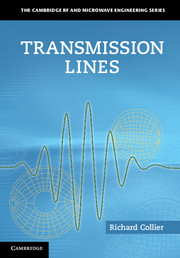Book contents
6 - Attenuation in transmission lines
from Part 2 - Transmission lines using electromagnetic theory
Published online by Cambridge University Press: 05 March 2013
Summary
In the preceding five chapters the topic of attenuation has been largely omitted. One reason for this was to simplify the text as the ‘loss-less’ or ‘loss-free’ theory is much easier than that for ‘lossy’ lines. Another reason is that attenuation in many transmission lines is not the major characteristic, particularly for short lengths of line. This means that the discussions in the previous five chapters are sufficient if the losses are small. However, no account of transmission lines would be complete without a discussion of the main causes and effects of attenuation. The chapter will begin with a return to the equivalent circuit method as this enables the two main mechanisms for attenuation to be introduced in a straightforward manner. After that, the concepts will be extended to those transmission lines that require electromagnetic waves for their solutions. Finally, some other aspects of attenuation will be discussed, including dispersion and pulse distortion.
Attenuation in two conductor transmission lines
At the beginning of Chapter 1, an equivalent circuit for a short length of loss-less transmission line was shown in Figure 1.1. In order to introduce the two main sources of attenuation, this diagram now needs amending. Firstly, any conductors will have some electrical resistance (curiously even for superconducting wires at microwave frequencies there will be some resistance, if there are still some unpaired electrons!) and this resistance can be represented as a series distributed resistance, R, which will have the units of Ωm−1. The other source of attenuation is the loss that occurs due to a dielectric having a small conductance. This can be represented by a parallel distributed conductance G with units of Sm−1. The effect of both of these resistive elements is to remove energy from the wave in proportion to the square of its amplitude. Not surprisingly, this results in an exponential decay of a sine wave.
- Type
- Chapter
- Information
- Transmission LinesEquivalent Circuits, Electromagnetic Theory, and Photons, pp. 208 - 252Publisher: Cambridge University PressPrint publication year: 2013



